All Nippon Airways and Japan Airlines respond differently to country's LCCs; is JAL faring better?
Whisper it quietly, but Japan's low-cost carriers appear to be cannibalising traffic at All Nippon Airways and Japan Airlines. ANA and JAL carried 19% fewer passengers between Osaka and Sapporo in 2012 than 2010 despite the overall market growing 20%. This goes against the story all parties tell that LCCs are only increasing, not cannibalising, volumes. The cannibalisation is confined, so far, but there are signs of concern. ANA and JAL saw reduced traffic in 2012 on overlapping LCC routes despite overall 2012 traffic being the strongest in nearly five years.
ANA and JAL are responding differently to LCCs. The nuances reflect their wider outlook - and fears. JAL is more aggressively cutting capacity on overlapping LCC routes while ANA is sometimes growing. In the medium-term, JAL expects to cut overall domestic capacity in line with the country's shrinking nature while ANA plans growth. JAL's cuts have been rewarded with higher load factors while ANA's growth has seen lower load factors, but all load factors need improvement.
Domestic flights from international airports are headaches; JAL's Narita-Fukuoka service averaged a 36% load factor in 2012. These are largely connecting flights for onwards international services. Ideally the international flights would be moved to domestic-oriented Haneda, but JAL received fewer international slots at Haneda than ANA. The LCC impact is also distinctly different in Tokyo than Osaka.
It is early days. The LCCs are still small but growing. They overlap only on a handful of routes, but this includes some trunk routes. Yield information is unavailable but so far JAL seems to be faring better with higher load factors. This meshes with its corporate strategy of having higher operating margins than ANA, perhaps providing confidence to investors weary of airlines - and JAL's bankruptcy history.
This report uses route-by-route airline and regulator data to asses how ANA and JAL have fared on the three largest domestic routes (Fukuoka, Naha and Sapporo) from each of the country's LCC bases: Osaka Kansai (for Peach) and Tokyo Narita (for Jetstar Japan and AirAsia Japan, re-branding as Vanilla Air in Nov-2013). The comparison is over three years, 2010 to 2012. 2012 is the first year of large-scale LCC presence while 2011 is distorted due to the east Japan earthquake that struck in Mar-2011 and depressed traffic that year. 2010 provides a baseline comparison. Many examples comparing Japan pre and post-LCCs only compare 2012 to 2011. 2012 figures naturally show growth compared to 2011 given passengers figures were artificially low that year. Comparing 2012 to 2010 provides a more insightful comparison. Both passenger numbers and load factors are evaluated.
Data for international flights is unavailable. The domestic market is the heart of Japanese operations, and higher yielding. But they are putting the growth focus in international, and Peach for one plans to be more prominent in the international market than domestic.
What emerges below are a number of themes and questions for how the market might evolve further.
1) ANA and JAL have a stronger outlook in Tokyo than Osaka
The Tokyo-based LCCs are at Narita, which is farther from Haneda airport than Osaka Kansai is from Osaka Itami. Whereas Tokyo Haneda has a large domestic network, its counterpart in Osaka, Itami airport, has a comparatively smaller domestic network. For example, three times as many Sapporo-bound passengers fly from Kansai than Itami; Kansai has 64% of the market while Itami and Kobe have 36% (see table below).
But in Tokyo, Haneda has nearly 10 times the Sapporo volume as Narita; Haneda has 90% of the market while Narita only has 10%. These figures are the same as Tokyo-Fukuoka and Tokyo-Naha. There is greater balance in Osaka. Most other cities in Japan have a single airport and not a split system like in Osaka and Tokyo. As the LCCs open additional bases, is there more concern for ANA and JAL? AirAsia Japan and Jetstar Japan made Nagoya a focus city but AirAsia Japan is pulling down due to its restructure as Vanilla Air. Peach has flagged a base at Okinawa, albeit geared towards international routes. Further bases are planned.
Share of passengers between domestic and international airports on select markets: 2012
|
|
Domestic Airports |
International Airport |
|
Sapporo-Osaka |
36% |
64% |
|
Sapporo-Tokyo |
90% |
10% |
|
|
Domestic Airports |
International Airport |
|
Fukuoka-Osaka |
54% |
56% |
|
Fukuoka-Tokyo |
90% |
10% |
|
|
Domestic Airports |
International Airport |
|
Naha-Osaka |
48% |
52% |
|
Naha-Tokyo |
90% |
10% |
2) JAL is more aggressively cutting capacity than ANA
Of the six markets under examination in this report, ANA in 2012 carried fewer passengers on five of them than in 2010. The exception was Tokyo-Sapporo where ANA carried 0.4% more passengers in 2012 than 2010. JAL has cut capacity in all six markets. And not just that, but its cuts have generally been larger than ANA's. Decreases at JAL could be expected since overall it carried 10% fewer passengers in 2012 than 2010 (ANA recorded modest growth while the overall market grew 4.5%). But JAL's decrease in the markets under examination is far greater than its average decrease.
Changes in passengers carried on select markets with LCC presence: FY201o to FY2012
| Osaka-Sapporo | Osaka-Fukuoka | Osaka-Naha | |
| Market Total | +19.5% | +24.3% | +5.0% |
| ANA | -12.0% | -17.4% | -6.7% |
| JAL | -28.7% | -69.1% | -24.9% |
| Tokyo-Sapporo | Tokyo-Fukuoka | Tokyo-Naha | |
|---|---|---|---|
| Market Total | +4.9% | +9.0% | +5.4% |
| ANA | +0.39% | -0.68% | -0.37% |
| JAL | -7.4% | -3.6% | -2.8% |
3) Full-service airlines are cutting capacity while LCCs are growing - which is the driving force?
A full analysis on LCC cannibalisation will require time. Peach is the longest serving of the new LCCs and it is only 18 months old. For now, the basic facts are that on overlapping routes, full-service carriers in 2012 generally carried fewer passengers than they did in 2010. LCCs have picked up those passenger numbers and further grown the market.
Between Osaka and Sapporo, ANA and JAL carried 19% fewer passengers in 2012 than 2010 while the overall market grew 20%. Some declines started in 2011, but it is difficult to pinpoint that on the Mar-2011 earthquake (producing a temporary decline further negated by the LCC entry), or other factors (producing a long-term decline irrespective of LCCs). In addition to stimulating new demand, the LCCs could be picking up traffic the full-service carriers are dropping, or the full-service carriers are dropping passengers because of the LCCs.
As LCCs grow, can ANA and JAL continue to have stronger performance elsewhere to shoulder the LCC impact? Is Japan capable of producing more full-service demand? Or will top-level figures begin to show wear? And what is the route-by-route yield impact so far?
4) Higher load factors would change the game; Skymark offers an example
A key element to a successful LCC is typically higher load factors than full-service counterparts. This makes the operation more efficient and reduces unit costs. LCCs typically have a higher break-even point than full-service carriers, so the higher load factors are also out of necessity. Skymark's load factor in 2010 was 15ppt higher than the system average but this has declined and in 2012 is only 5ppt higher. But Skymark's network comprises competitive trunk routes and uncompetitive regional routes. On the former, Skymark's load factor is significantly higher. On Tokyo Haneda-Sapporo, Skymark's 2012 load factor was 81.4% against a system average on the route of 67.7%.
ANA, JAL, Skymark and Japan average domestic load factor: 2010-2012
| 2012 | 2011 | 2010 | |
| ANA | 61.8% | 60.8% | 63.2% |
| JAL | 63.1% | 62.7% | 61.8% |
| Skymark | 68.4% | 76.2% | 78.4% |
| Japan average | 63.7% | 63.1% | 63.7% |
Japan's entire domestic market would change if ANA and JAL pursued higher load factors. They could stimulate new traffic and win back share from Skymark and others. Alternatively they could keep passenger numbers but condense flights, creating significant savings. Even ignoring LCCs, ANA and JAL could see significant profit increases if only they followed other major domestic markets in having 80% or so load factors.
5) Weak domestic flights from international airports are small but need addressing- can ANA/JAL work with their LCCs?
Even by Japanese standards, the load factors on some domestic flights from international airports are poor. These flights primarily function to feed ANA and JAL's international networks. Until recently, international long-haul flights from Tokyo departed from Narita while domestic flights were mainly operated out of Haneda. Transferring between the two airports takes at least two hours, so domestic flights from Narita helped facilitate the hub network.
But these flights come with a cost. JAL's Narita-Fukuoka service operated at a 36.1% load factor in 2012. This is not just because of LCCs serving the Narita-Fukuoka route in 2012. The route had a 36.2% load factor in 2011 and 53.3% in 2010. So there was weakness even before LCCs entered. ANA has not fared much better with a 46.2% load factor in 2012 on Narita-Fukuoka. Nor is this low performance unusual. ANA and JAL respectively reported Narita-Naha load factors of 54.8% and 47.5% in 2012.
The two hovered around 52% on Narita-Sapporo, over 10ppt lower than their Haneda-Sapporo performance. Out of Kansai, ANA reported 49.1% to Fukuoka. Kansai-Naha was strong for such a route with ANA and JAL reporting respective load factors of 65.8% and 73%. But there were 5-10ppt lower than Itami-Naha. Additionally, JAL pre-emptively suspended Narita-Kansai, which was one of Jetstar Japan's first routes.
It is true these routes are small. Haneda-Sapporo is 10 times larger than Narita-Sapporo. But these routes are a financial burden, and addressing them would bring a disproportionately large benefit. So what to do? JAL has already started a codeshare on Jetstar Japan where a passenger taking an international flight can alternatively connect on Jetstar instead of JAL. But in practice, JAL does not always offer Jetstar Japan connections in the booking process.
JAL also seems hesitant to end overlapping domestic flights. It may be concerned about service incongruity. But to Fukuoka and Sapporo from Tokyo, the flight time is under two hours - there is barely even an opportunity to offend. Not that Jetstar Japan would: Jetstar-JAL connecting passengers receive free luggage allowance on Jetstar and other perks, like lounge access. There could be improvements to better accommodate premium passengers but there is not considerable pressure: on JAL's 737-800, premium seats are in a 2-3 configuration, only one seat less than economy's 3-3.
If the logistics make sense, the restraint is probably on pride: JAL being seen as "giving up" routes to its low-cost arm. Even in a mature dual-brand strategy like Qantas-Jetstar, territoriality is high, but this seldom seeps out to the public. In Europe, the unions strike. JAL has an advantage over ANA. JAL and Jetstar Japan are slightly integrated. Besides the codesharing, JAL and Jetstar Japan jointly plan networks. ANA is hands off from Peach, with the two having no intent to interline, let alone codeshare. This is largely driven by Peach wanting to limit the involvement of high-cost ANA, which is only a minority shareholder.
Likewise AirAsia Japan was distanced from ANA (a majority owner) but open to working with other AirAsia Group carriers. With the evolution of AirAsia Japan to Vanilla Air, and ANA becoming the full owner, the scenario may change. It is unclear what level of cooperation Vanilla will have with ANA. There could be reception to cooperation given than ANA intends for Vanilla Air to enter markets ANA has either abandoned or never served.
See related reports:
- Vanilla Air to give owner ANA a presence in abandoned markets while offering a hybrid model
- Japan Airlines and Jetstar Japan embrace LCC hybridity, codesharing - and reap rewards
- Japan LCC era yet to enter full swing, but route cannibalisation starts
6) The LCCs are generating new passengers - is the tourism awake yet and able to respond?
In large LCC markets like Southeast Asia and Europe, LCCs were the missing link to connect passengers with inexpensive tourism infrastructure from hotels to restaurants. There was certainly an abundance of growth in lower-cost offerings once additional passengers arrived, many on LCCs. But that is not the case in Japan, where offerings are largely expensive. While it is true the "fly cheap, stay chic" maxim of taking a low-cost flight and then splurging on arrival is a trend, even moderate offerings in Japan are more expensive than in other markets. This is true from hotels to ground transport. Are LCCs the link to an expensive destination?
There are signs of change. Jetstar Japan partnered with a bus company to provide cheaper access to Narita airport, whose ground transport charges are notorious. Airports also received the memo and have constructed or are constructing low-cost facilities. But this needs to trickle down further. Capitalism and entrepreneurialism come into play, but nudges are good too.
This is especially true given the larger trend of the Japanese economy. The weakening of the yen is designed to make the country cheaper, be it for visitors or manufacturers. But for tourism, Japan is mainly an outbound market. It will have to push inbound visitors. Cheaper flights will help, but Japan must break its stereotype as an expensive destination. This will be especially important for airlines if inbound visitors are to offset any decline in outbound visitors who find their yen no longer commands the wealth it once did. While the Japanese LCCs are looking to leverage their appeal to their home market, Taipei routes for example are mainly comprised of Taiwanese, not Japanese.
The tourism-LCC pattern is a good one to have a repeating cycle. Inexpensive flights bring people looking for more affordable options, the supply of which generates buzz and further air demand.
7) JAL going for quality, ANA for quantity?
JAL's more aggressive capacity cuts may reflect larger trends in the market. In FY2016, JAL plans to fly 3% fewer ASKs than it did in FY2011. ANA is planning unspecified growth in the medium term. JAL's cuts are especially notable given the rarity of an airline predicting not only a smaller future, but cuts below previous years, which were smaller than current ones.
In tandem with the reduced capacity, JAL is planning for double-digit operating margins. This should be achievable: its FY2011 margin was a staggering 17%. It is true that ANA is also planning for double-digit operating margins in the medium term. But this seems more challenging: ANA's FY2011 and FY2012 operating margins were about 7%. ANA forecasts FY2013 to have a 7.8% margin; this is a downward revision from the 8.5% forecast just a year ago.
See related report: Japan Airlines' 17% margin may be envy of the industry, but JAL's outlook is less upbeat
So is JAL pursuing quality (higher margins) while ANA goes for quantity (large volumes)? Or is JAL simply being pragmatic in expecting a decline in demand - meaning ANA is in for a shock? These plans were set before the country's "Abenomics" programme. Even a one-year outcome from the government-led initiatives is cloudy, so it is difficult to predict what demand these economic changes will yield in the long term.
2012 traffic in Japan was 4.5% larger than in 2010; ANA grew 1.3% while JAL shrunk 10%
The context for discussing market-by-market performance is as follows: FY2012 had the best domestic performance in five years. The overall market grew by 4.5% compared to 2010. 2010 serves as a baseline since 2011 was distorted due to the Mar-2011 earthquake. But between 2010 and 2012, JAL shrunk by 10% while ANA grew by 1.3%. This is a contrast to the overlapping LCC routes where ANA generally saw fewer passengers in 2012 than 2010 while JAL saw a sharper decrease. Notable is the growth from Skymark, Japan's third-largest carrier albeit significantly smaller compared to ANA and JAL. Skymark grew by 51% between 2010 and 2012.
Domestic passengers carried by Japan's three largest airlines on all routes: FY2010-2012
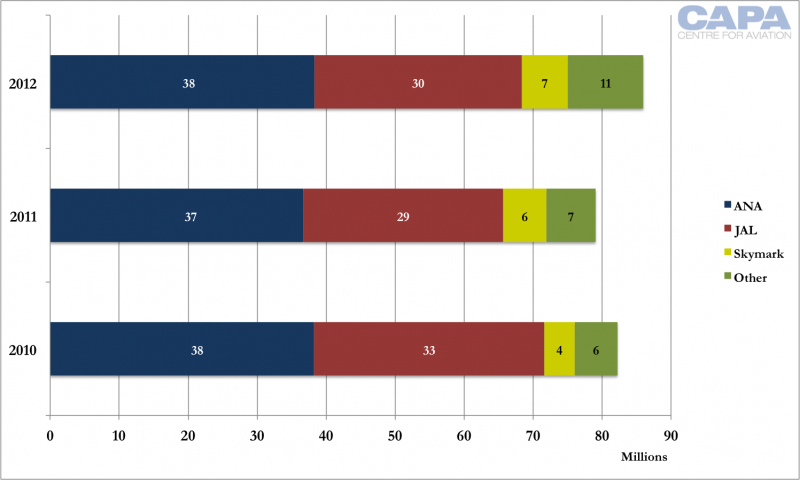
See related report: LCCs help Japanese domestic market grow for first time in six years, but market situation still dire
Osaka-Sapporo: overall growth of 20% but ANA loses 12% of passengers, JAL 29%
The Osaka-Sapporo market, one of Japan's top 20, grew 19.5% in FY2012 compared to FY2010, ahead of the national average of 4.5%. Some growth came from Skymark but most from the country's new LCCs, which comprise the passenger numbers in the "other" category for 2012 in the graph below. (Skymark's growth was short-lived and one route was cancelled at the end of FY2012, so FY2013 numbers should be lower.)
The overall story is positive, but the growth came at the expense of declines at ANA and JAL, who respectively lose 12% and 29% of their passengers between FY2010 and FY2012. There was some decline in FY2011, but most occurred in FY2012. Both Peach and Jetstar Japan operated between Osaka and Sapporo.
Domestic passengers in the Osaka-Sapporo market: FY2010-2012
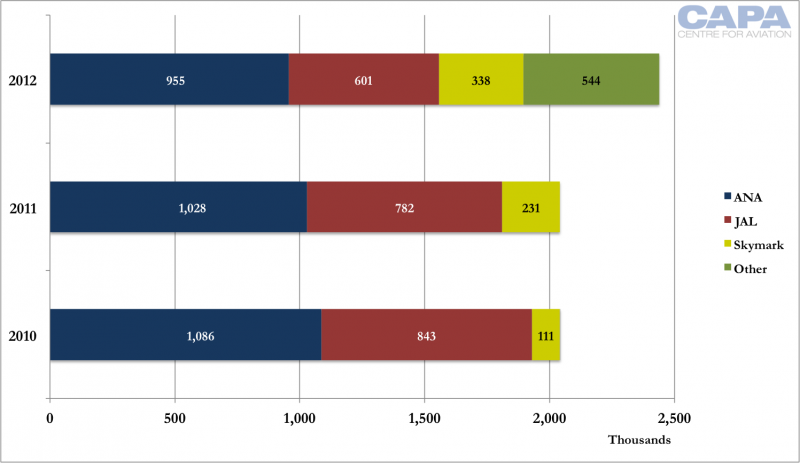
ANA and JAL saw weakening load factors. Most Sapporo-bound capacity is concentrated from Kansai airport, from where Peach and Jetstar Japan fly. JAL's Kansai-Sapporo load factor declined from 67.4% to 59.9% while ANA declined marginally from 64.6% to 64.0%. On Itami-Sapporo, JAL improved from 71.9% to 76.4% while ANA declined from 74.3% to 68.8%. In Kobe-Sapporo, ANA declined from 62.3% to 55.2%. Skymark operates to Sapporo from Kansai and Kobe but suspended Kansai-Sapporo in Mar-2013 due to weak performance; its load factor was 53.9% according to data kept by Japan Aviation Management Research. Yields were also likely low. Kobe-Sapporo has not fared well for Skymark, with load factors declining from 84.8% in FY2010 to 58.3% in FY2012.
In 18 months LCCs gain 41% of the Osaka-Fukuoka market
Fukuoka is the largest LCC destination from Osaka and they have gained incredible traction, comprising 41% of the market. This is helped by the route's short distance - about 451km. LCCs historically perform better on short routes as their cost saving is more apparent and passengers are more willing to fly a LCC as there is limited time to experience the lesser service. JAL saw drastic declines in passenger numbers in FY2011 with slightly smaller declines in FY2012. But ANA saw a sharp drop in passengers in FY2012 compared to FY2011. But like Osaka-Sapporo, the LCCs grew the overall market - by 18.9%.
Domestic passengers in the Osaka-Fukuoka market: FY2010-2012
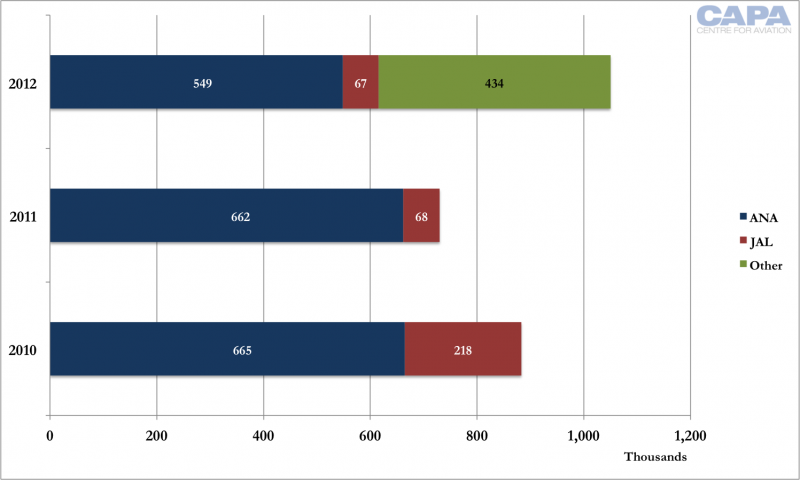
ANA has the majority of its Fukuoka capacity from Osaka Itami while JAL now has all of its Fukuoka capacity operate from Itami. JAL's decline, however, has brought some efficiency as load factors increased from 62.1% to 65.9%. ANA has seen a small decline from 61.9% to 61% but ANA's Kansai-Fukuoka performance has shown worse performance, with load factors declining from 54.7% to 49.1%. The efficiency of LCCs is noticeable in the Kansai-Fukuoka segment where, following the entry of LCCs, average load factors have increased dramatically from 57.5% to 75.2%.
LCCs make smaller inroads in the Osaka-Okinawa Naha market
Osaka-Okinawa recorded 5% passenger growth in FY2012 compared to FY2010. While this is more modest growth compared to other markets the LCCs entered, this is still above the average 4.5% growth in Japan and is not shabby performance. ANA saw a decrease of 6.8% while JAL had a more drastic fall of 24.9%, albeit from a slightly smaller base. Skymark has grown 9.9%.
Domestic passengers in the Osaka-Okinawa Naha market: FY2010-2012
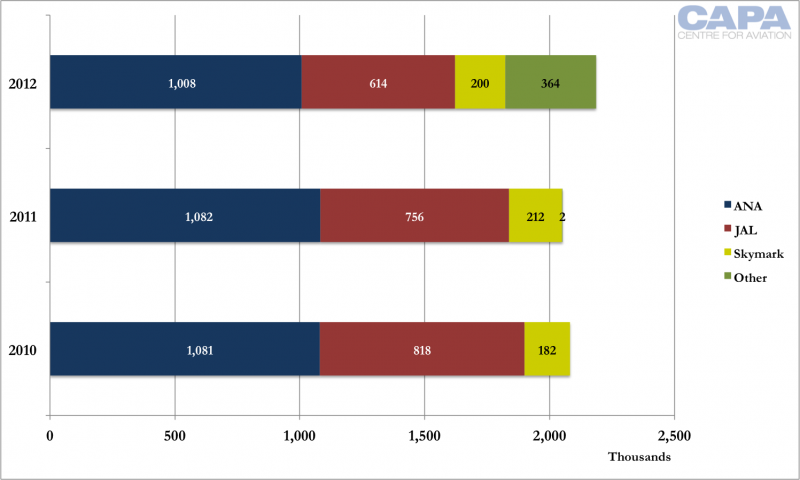
JAL's cuts have once again been paired with increases in load factors. Most of its Naha capacity is from Kansai, and Kansai-Naha load factors increased from 71.4% to 73%. Itami-Naha also recorded improvements with load factors increasing from 76.2% 78.8%. ANA's performance was mixed: Kansai-Naha increased from 64.3% to 65.8% but Itami-Naha decreased from 77.0% to 75.4% while Kobe-Naha decreased from 63.1% to 56.1%. ANA's decline in passengers is most apparent in the Kobe-Naha market and seems to coincide with Skymark's expansion. But Skymark, a hybrid carrier, has seen its Kobe-Naha load factor decline from 71% to 57.8%.
World's largest market, Tokyo-Sapporo, fares best; only market seeing growth for ANA
Tokyo-Sapporo is the world's largest market when comparing capacity from all Tokyo area airports. Looking solely at routes, Tokyo Haneda-Sapporo is behind Seoul Gimpo-Jeju, but including Narita-Sapporo capacity, Tokyo-Sapporo edges ahead of the larger Seoul (Gimpo and Incheon)-Jeju market.
Tokyo-Sapporo is also the only market in this examination where ANA recorded growth, although it was a very modest 0.4%. JAL saw a 7.5% decrease, which is less than its average system decrease. Skymark had growth of 19.4%. The new LCCs (AirAsia Japan and Jetstar Japan served Tokyo Narita-Sapporo) accounted for only 4.3% of the market in FY2012, although it should be noted they launched mid-way through the year. But they are responsible for the majority of the growth. The market could soon exceed 10 million annual passengers.
Domestic passengers in the Tokyo-Sapporo market: FY2010-2012
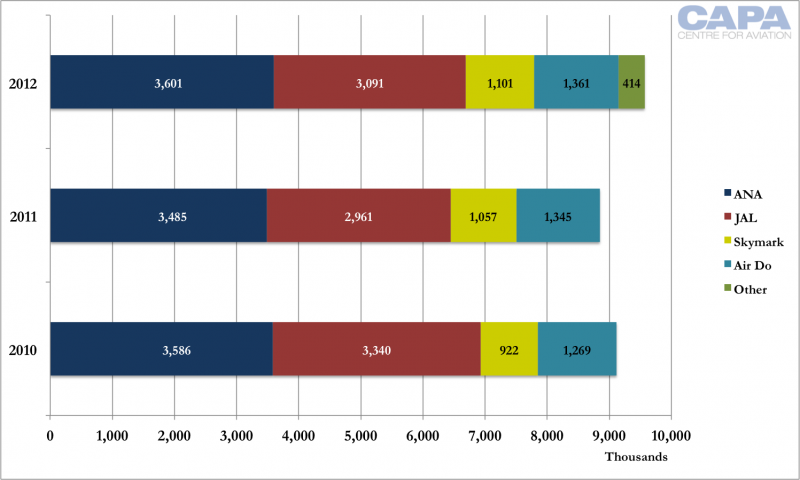
JAL once again saw load factors increase. Haneda-Sapporo improved from 60.3% to 67.4%, above JAL's system average. ANA declined from 65.6% to 63.9% while Skymark declined from 89.6% to 81.4%. In the smaller Narita-Sapporo market, JAL declined from 54.5% to 51.9% while ANA improved from 48.1% to 52.2%.
Tokyo-Fukuoka, Japan's second-largest market, mirrors that of Tokyo-Sapporo
Amongst the incumbents, Tokyo-Fukuoka has seen little change, similar to Tokyo-Sapporo. Both ANA and JAL saw passenger declines, but this was filled by a combination of Skymark, Starflyer and the LCCs, which helped the market grow 9.0%, far more than the 4.9% growth in Tokyo-Sapporo. Tokyo-Fukuoka is Japan's second-largest market and not far behind Tokyo-Sapporo.
Domestic passengers in the Tokyo-Fukuoka market: FY2010-2012
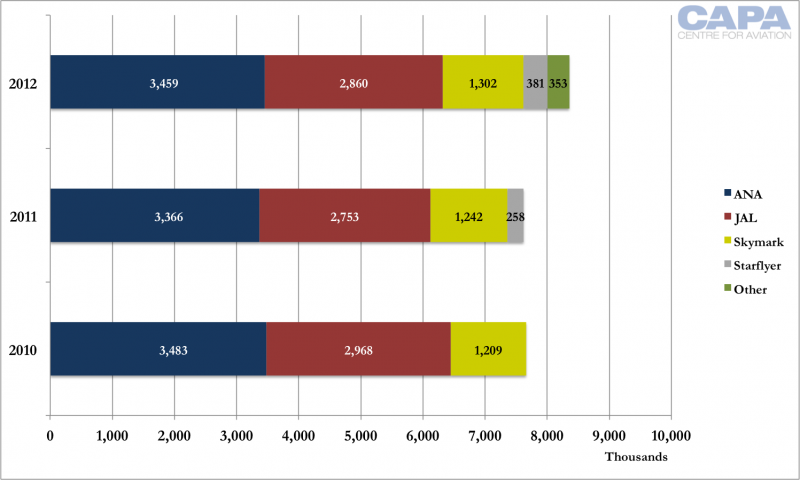
Load factors are a diverging story. In the much larger Haneda-Fukuoka market, JAL improved from 60.2% to 63.6% while ANA improved from 61.5% to 62.7%. But Narita-Fukuoka load factors have become an eyesore, with JAL deteriorating from 53.3% to 36.1% and ANA from 61.5% to 46.2%.
LCCs grow faster than Skymark in Tokyo-Okinawa Naha
Another theme has been the ability for LCCs to grow faster in one year than Skymark could achieve over two years. Skymark from FY2010 to FY2012 gained approximately 141,000 passengers in the Tokyo-Okinawa Naha market but the new LCCs carried about 226,000 passengers in their first year, 40% of Skymark's FY2012 total. The scenario is distorted as the LCCs are understandably putting in large volumes at the start and growth will taper, but it will be interesting to see the growth rates of the LCCs compared to Skymark.
The Tokyo-Okinawa Naha market was relatively flat between ANA and JAL from FY2010 to FY2012, although both saw limited decreases. Skymark and the new LCCs ensured the overall market grew 5.4%, slightly ahead of the system average.
Domestic passengers in the Tokyo-Okinawa Naha market: FY2010-2012
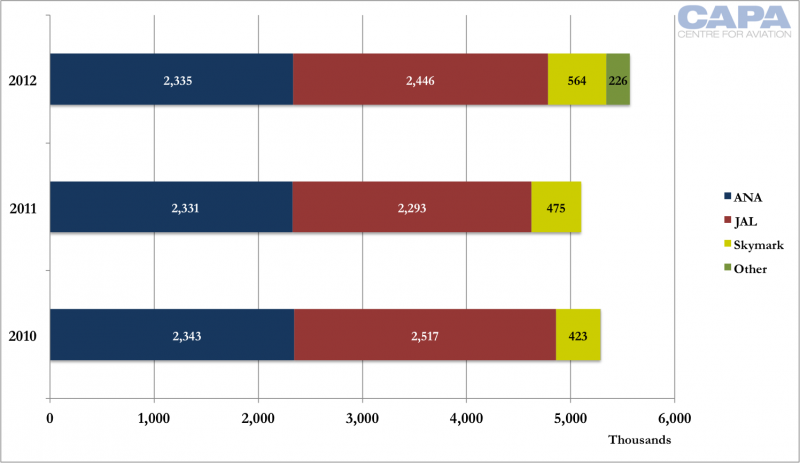
JAL's Haneda-Naha load factor declined marginally from 64.9% to 64.3% while ANA improved from 68.4% to 71.4%. Skymark dipped from 85.6% to 82%. Narita-Naha was predictably weak, with JAL's load factor decreasing from 50.8% to 47.5% and ANA from 55.2% 54.8%. Despite these dips, the average Narita-Naha load factor increased from 53.7% to 59.4%, indicating higher LCC load factors are off-setting declining performance at ANA and JAL.
Outlook: JAL seems to be faring better, Haneda constraints could shift growth to Narita, and Japan wins
Yield information for the routes is not supplied, but overall ANA and JAL saw average FY2012 yields decrease by 2%. At this early stage, JAL's strategy seems wiser than ANA's. Both have seen dips in passenger numbers but generally JAL has improved efficiency with higher load factors while ANA is seeing lower load factors. But JAL's sharp rate of decline in some markets in questionable, especially since its bankruptcy restructuring has seen it emerge with a more efficient operation than ANA - so theoretically at least JAL should be able to out-perform ANA thanks to its now-lower costs.
There has been much discussion about the latent demand around Osaka as traditional airlines focused on Tokyo. It is true that in this study Osaka markets have grown proportionally more than their Tokyo counterparts, with the three Osaka markets growing 14.2% between FY2010 and FY2012 compared to the three Tokyo markets growing 6.5%. But Tokyo's larger size means the growth was an additional 1.4 million passengers in FY2012 while in Osaka it was only 700,000. Not all of this is from LCCs, but much is. Yet curiously, despite the latent Osaka demand talk, ANA and JAL have cut more capacity there than in Tokyo.
There may have been an over supply to begin with in Osaka, but in Tokyo, Haneda is slot-restrained. Any decrease in Haneda slot usage means another airline could receive the unused slot, so running some over-capacity may be better than helping a competitor. The slot situation is so delicate that after the Mar-2011 earthquake, there was a formal process to ensure slots would not be re-distributed if airlines did not use them owing to weakened demand. To an outsider, the concept of not having to surrender slots would be obvious: FY2011 traffic was the lowest since FY1995. But Haneda slots are scarce and for some carriers, the lifeblood to profitability. (This contrasts to China, where carriers that decreased frequencies during the global financial crisis did not receive the slots back.)
The restrained nature of Haneda may see the growth story shift in coming years. There is talk of Japan's airlines being galvanised by the Tokyo Olympic award to push for more expansion at Haneda. But after a small domestic expansion a few years ago and the awarding of a few more slots in late 2012, there is no planned domestic slot growth at Haneda. Any increase will have to come through capacity chances, and indeed Skymark is planning to up-gauge 737s to A330s from 2014. Potentially, any new demand that emerges will be more likely to fly out of Narita, and by one of the LCCs. Then the LCC growth from Tokyo may begin to catch up with Osaka.
For Japan, the conclusion is clear: passenger numbers are finally growing after nearly a decade of decline. Indeed, the domestic growth from FY2010 to FY2012 was the strongest in about 15 years. But for ANA and JAL, the picture is mixed. JAL plans cuts in the medium term while ANA plans growth. Yet in all but one major LCC/full-service carrier overlapping market, they both cut capacity. This begins to underscore the shift they are each undertaking to growth their international, and especially long-haul networks.
This is out of opportunity and necessity. Expect no tears or over-arching protectionism from the government: the shock wave of liberalisation (open skies, airport reform) that facilitated the entry of LCCs was designed to boost passenger numbers and the larger economy. Japan will continue to be rewarded from that heroic decision, and hopefully inspire the many laggard nations.